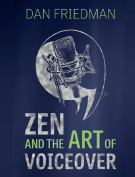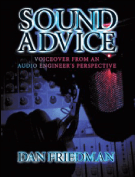
You’re about to begin directing voice talent. You may be producing a TV or radio commercial. Maybe you’re producing a corporate presentation or program narration. Whatever the project is, your goal will be to get your chosen voice talent to communicate your message(s) to your audience. Your message could be many things, but one thing is almost certain… it is probably more than just the words written on the page. Directing voice talent to communicate both the written and unwritten messages within your script takes skill and flexibility. You must also be certain as to what your message is meant to communicate. Furthermore, it helps to have the ability to communicate effectively yourself and a willingness to allow your talent and your engineer/producer to help you achieve your goal.
Who Will Deliver and How?
The most important thing to know and understand before beginning is… your message. What do you want your message to be? What emotions are you trying to evoke in your audience? The answer to these questions will determine how you want that message delivered and who will be best at delivering it. Your choice of talent is critical. Often a voice talent with a bold announcer’s voice will be chosen to do a role that would be better suited to someone with a regular-guy/gal voice, and vice-versa. These contradictions make it difficult to hear the message beyond the voice. Simply hearing a nice voice speak your written words is not enough. The emotion comes from how those words are delivered. As the director, you need to determine what voice is right for a role, as well as the type of delivery that will communicate your message and elicit the desired response from your audience.
Professional voice talent should be able to look over your script and know reasonably quickly what type of delivery is required. Most often the words will dictate what the message should be. However, as the talent reads the script aloud, the director maxalt max should be listening for the nuances in the delivery. There is more than one way to effectively communicate a message and the director should be sure to listen carefully to those nuances and determine which communicates the message best.
Keep it Simple and Clear
When offering direction to voice talent, keep it simple and succinct. The more direction you offer at one time, the less likely you will be to get everything you need or want.
Lots of directions… often lead to contradictions. These contradictions lead to confusion. This invariably means that it will take more time to get your message where it needs to go (which possibly means spending more money as well). Directing a voice talent is analogous to being a passenger in a car and telling the driver where he or she needs to go. If the passenger tells the driver to go both right and left at the same time and at the last possible second, the driver is likely to crash. Even when the direction is clear, offering too much direction or too much explanation, can also present a problem. Going back to the passenger and driver analogy; if the passenger tells the driver he’ll have to turn right but then continues to explain the right turn or begins to discuss what will happen after that (or really just about anything that takes the drivers attention away from the road), the driver could miss the turn entirely.
Using descriptive and unambiguous terminology is another key factor in hastening your success. Telling the talent to make it “flat”, for example, could mean many things. Does it mean to read without emotion, without inflection, or to simply read the script conversationally and not sound like an announcer? Terms such as: “dramatic”, “forceful”, “proud”, “nonchalant”, “conversational”, with “more/less energy”, or “more/less smile” are much easier to understand. Books about voice over (the same books that voice talent read) can be very helpful when directing. Many offer a more comprehensive list of terms and also explain delivery styles.
Trust Your Engineer
Some voice talents respond very well to concepts. They may want to know who the audience is or what the setting will be. Others need details, such as simple directives about inflections or emphasis on a line or word. Usually a combination of these things will be most effective. If you do not have experience directing or are unfamiliar with a particular voice talent, the engineer or producer can be a tremendous asset. Allow them to help you. One of the great things about working with an engineer or producer who is experienced in voiceover is that they often work with many of the same people on many different projects. They get to know the talent well and know how each responds to different ways of directing. If you are having trouble explaining what it is you want to hear, the engineer or producer may be able to interpret your needs and convey them to the talent in a way that the talent responds best.
Line Reading… The Last Resort
Still not able to get what you want from your voice talent? As a last resort… offer a line read. It is rarely a good idea to start a recording session by offering a line read. Line reading is usually unnecessary and can be misleading. After all, the talent was hired for more than just their voice. They were also hired for their interpretation skills. William Shatner famously coerced a director to line read for him after the director gave Mr. Shatner several unnecessary directions about his delivery. Needless to say, the director couldn’t begin to deliver the message like William Shatner, and Mr. Shatner was quick to let him know it. That session is legendary in the voiceover community and the audio is available here.
This director surely learned that line reading can lead to big problems. Thankfully, most voice artists will not be as brazen as Mr. Shatner was with this particular director on that particular day. Many voice artists will kindly ask for a line read after they’ve made several attempts and still aren’t delivering a line the way you hear it in your head. Most voice talents are very appreciative to have been chosen to deliver your messages. They are more than willing to do what is necessary to give you the read you want. That being said, it is still a good idea to save line reading for small parts, pronunciations and when all other methods of communicating your needs have failed.
Directing voice talent can be the easiest and best part of your workday. If you understand your messages and communicate them to the talent and the engineers/producers as simply and clearly as possible; you’ll be able to sit back, relax and allow the talents of your chosen voice artist, and engineer, communicate your message to the world.
 Am I ready to make your first
Am I ready to make your first 


